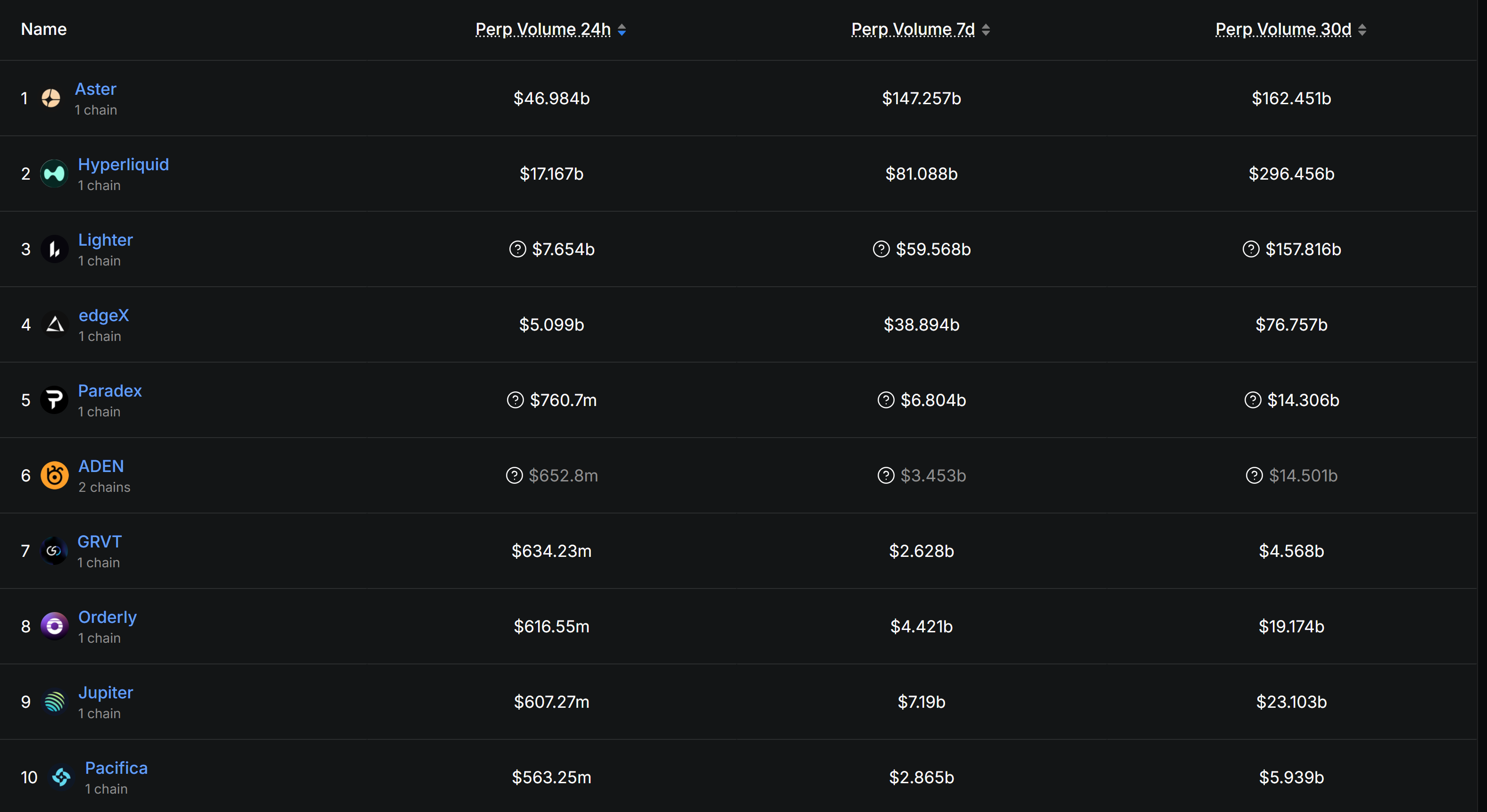BNB DEXs Could Overtake Hyperliquid on Perp Volume as Retail Traders and Quants Fuel On-Chain Growth
BNB
BNB/USDT
$659,934,522.24
$917.33 / $896.85
Change: $20.48 (2.28%)
-0.0039%
Shorts pay
Contents
Decentralized exchanges (DEXs) are rapidly closing the execution gap with centralized exchanges (CEXs), with retail traders and quant strategies driving DEX growth while institutions stick to CEXs for fiat rails and prime brokerage. Onchain perps are gaining market share via speed, incentives and auditable order books.
-
Retail and quants are fueling DEX growth with incentives and low-latency fills.
-
Institutions continue to use CEXs for fiat, compliance and prime services.
-
Onchain order-book DEXs now match CEX latency and depth; Aster recently posted higher daily perp volume than Hyperliquid.
Decentralized exchanges (DEXs) close the CEX execution gap—learn why retail, quants and onchain order books are driving a new era of perps. Read now.
Retail and quants are fueling DEXs like Hyperliquid, while CEXs hold institutional ground. Aster’s rise adds new pressure to the onchain race.
What is driving DEX adoption among retail traders and quants?
Decentralized exchanges (DEXs) are attracting retail traders and semi-professional quants because they combine onchain transparency, incentive programs and low-latency fills. Platforms with onchain central limit order books deliver auditable order flow and sub-second finality while preserving self-custody and low per-trade friction.
How do DEXs match CEX execution quality?
Order-book based DEXs—examples include Hyperliquid, dYdX v4 and GMX—have narrowed the execution gap by optimizing chain finality and off-chain sequencing to reduce latency. These designs aim to deliver deep liquidity and fast fills while recording every order and fill onchain for auditability.
Competition on alternative chains has intensified. On BNB Chain, Aster’s incentive campaigns recently pushed daily perp volume to record highs, at times surpassing Hyperliquid.

Top 10 DEX perps. Source: DefiLlama
Why do institutions still prefer CEXs?
Institutions favor centralized exchanges for fiat rails, fiat on/off ramps, compliance tooling and prime brokerage services. These capabilities support large block trading, custody integrations, and regulated reporting—essentials for institutional desks that DEXs currently struggle to match at scale.
When do hybrid models make sense?
Hybrid models make sense when liquidity and compliance requirements coexist. Over the coming decade, expect architectures that combine onchain settlement and auditability with offchain fiat rails and custody—blending the strengths of DEXs and CEXs into interoperable workflows.
How do recent volumes compare between Aster and Hyperliquid?
Recent onchain metrics show Aster hitting roughly $47 billion in daily perp volume versus about $17 billion for Hyperliquid over a comparable 24-hour window, according to aggregated data from industry trackers. These spikes were driven by targeted incentive programs and onboarding flows.
| Protocol | Recent Daily Perp Volume (approx.) | Primary Chain |
|---|---|---|
| Aster | $47 billion | BNB Chain |
| Hyperliquid | $17 billion | Proprietary chain |
What risks should traders consider on DEXs?
DEXs expose traders to onchain-specific risks: validator or sequencer centralization, oracle failures, exploitable upgrade keys, bridge vulnerabilities, and liquidation engine stress during volatility. Exchanges occasionally reimburse affected traders; for example, Aster reimbursed traders after a Plasma (XPL) perpetual market glitch caused price spikes and forced liquidations.
Frequently Asked Questions
Can DEXs replace CEXs for institutional trading?
Not yet. Institutions rely on fiat rails, compliance and custody which CEXs provide. DEXs are improving execution but need broader institutional tooling before fully replacing CEX workflows.
How do onchain order books improve transparency?
Onchain order books record orders, cancellations and fills publicly, enabling independent audits and forensic analysis. This increases market transparency and reduces information asymmetry for traders.
What should retail traders watch for on fast-growing DEXs?
Monitor incentive sustainability, smart contract upgrade controls, oracle reliability and any reported sequencer centralization. Short-term volume spikes can mask lower long-term organic liquidity.
Key Takeaways
- Adoption drivers: Retail incentives and quant strategies are primary forces behind DEX volume growth.
- Execution parity: Order-book DEXs now approach CEX latency and depth while offering auditable onchain records.
- Coexistence: Expect hybrid models that combine onchain settlement with fiat rails and institutional tooling.
Conclusion
Decentralized exchanges are closing the technical and execution gap with centralized platforms, driven by retail incentives, quant demand and improved onchain order books. Institutions still depend on CEX infrastructure for fiat and compliance, so coexistence and hybrid architectures are the most likely path forward. Watch incentive sustainability and protocol risk as the market matures.
Comments
Yorumlar
Other Articles
Bitcoin Price Analysis: Will the Uptrend Continue?
1/11/2026
Ethereum 2.0 Update: How Will It Affect the Crypto Market?
1/10/2026
The Coming of Altcoin Season: Which Coins Will Stand Out?
1/9/2026
DeFi Protocols and Yield Farming Strategies
1/8/2026

